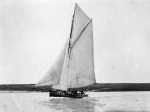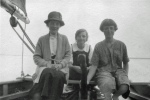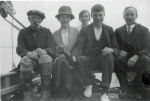This is the first of a three-part history of the Burnham oyster smack, the Mayfly. Built during the second half of the nineteenth century, and still sailing the waters of the Thames estuary, some 135 years on.
An oral history of the Mayfly has been passed down through the Stebbings family, re-ignited periodically as news of Mayfly’s latest adventures and whereabouts have come to light. One such occasion was in the mid-1970’s, when the Mayfly emerged onto the front covers of the sailing press and into national newspapers, as the amazing story of Graeme Dillon’s circumnavigation was told (this will form the basis of part-two of Mayfly’s story).
In 1998, the Mayfly appeared again, this time from underneath blue tarpaulin, when Harry Stebbings came across her being repaired in David Patient’s boatyard in Maldon. This occasion re-united Mayfly with Harry, and his cousin Bill Stebbings, both of whom had sailed her as young men, during the 1920s and 1930’s. Bill’s own memories of Mayfly were recorded by Pete Pearson during interviews and reminiscences with Bill, and Pete deserves much credit for this and many hours of similar recordings of the lives and work of those employed in Burnham’s boat building and related businesses.
Mayfly is still sailing in and around the Blackwater, from her mooring at West Mersea, and video footage of her under sail has been captured by Dylan Winter (Keep Turning Left) and can be found on YouTube (all of which will follow in part-three of the story).
At the outset, I should make plain that despite there being a broad range of historical fragments to draw upon, there remain gaps and uncertainties regarding some aspects of Mayfly’s history. I have no doubt, for the most part, in the accuracy of the individual records, but I have more work to do before I’ll be entirely satisfied that the story I’m about to tell is the true one.
A handwritten list, probably by William Stebbings, of boats built during the 1870’s and 1880’s recorded that the Mayfly was built in 1877. However, the story below from THE HALFPENNY NEWSMAN shows Mayfly was actually built in Burnham in 1875.
From THE ESSEX NEWSMAN, March 20th 1875.
LAUNCH AT BURNHAM – On Wednesday, a smart little vessel, which was named the May Fly, and which has been built by Mr. Wm. Stebbings for Mr. L. Sweeting, was successfully launched, and in the evening all those who had been engaged in the construction of the vessel partook of an excellent supper, which had been provided by Mr. J. Smith, of the Anchor Inn. Mr. A. Rowe presided, and the vice-chair was occupied by Mr. W. Stebbings. Several complimentary toasts, including to the health of Mr. Laban Sweeting and Mr. Spencer Addison, were proposed by the chairman, and were energetically responded to. Some good songs were sung by some of those present, and the evening’s proceedings were ultimately brought to an agreeable termination. The May Fly is much admired and does great credit to Mr. Stebbings, who has on former occasions turned out some first-rate craft.
Bill Stebbings’ recollection was that Mayfly was the last traditional oyster smack built by his Grandfather, William Stebbings. This rings true with what we know about William’s subsequent output, for although he produced a number of other working boats, all the oyster dredgers he went on to build after the Mayfly were powered by steam, and not sail.
Working for oyster merchant Mr. Laban Sweeting, Mayfly would have spent the first part of her working life as part of a large dredging fleet tending to the many oyster layings in the River Crouch at that time.
Mayfly first appears in the Register of Sea Fishing Boats for Colchester some time in the late 19th or early 20th century, where she is given the registration CK363. West Mersea is recorded as her home port at that time, and while her builder is recorded as ‘unknown’ a year of build has been entered as 1889, which I will assume was an error. The measurements recorded are not too far off those written down by her builder. There is a note made in 1910 to show that Mayfly’s owner was Edwin Langstaff Cooke, of Ipswich, and the skipper was an Arthur Cudmore. The entry in the Colchester register is crossed out in 1918, and it is noted that Mayfly had moved to London, where she was registered as LO258.
After her soujourn on the London river, Mayfly reappears in the Colchester Register of Sea Fishing Boats in 1923, whereupon she is registered as CK121. At that time she is recorded as having come back into the Stebbings family’s ownership. This time the registration shows her place of build as being Burnham (presumably William Stebbings jnr. put the authorities right on that matter), but the date of build is still down as 1889.
Mayfly had been found by the family in a pretty sorry state languishing in the mud at Foulness. Her builder, William Stebbings, had died in 1907, and so for sentimental reasons his sons William and Albert Harry contacted the owner and Mayfly was purchased for 25 pounds. She was extensively refitted and for just over a decade was used by the family as a yacht for day trips, fishing, smack races, local regattas, picnics, and teaching the younger family members to sail.
The photos above are from this time. The picture with the three women seated in the stern of Mayfly shows (L-R) Nellie Stebbings, Ellen Stebbings and Doris Rudston (who would later marry Robert Pipe, whose mother was Elizabeth Stebbings). The picture with five people shows Tom Ambrose, Nellie Stebbings, Ellen Stebbings, Harry Stebbings and Albert Harry Stebbings.
In 1934, a final note regarding the Mayfly appears in the Colchester Register of Sea Fishing Boats. It is recorded that an engine had been fitted and that Mayfly had been sold to Mr. Claude Scrutton of Thorpe Bay. Claude worked in his family’s London stevedore firm, Scrutton’s, but was a regular visitor to the River Crouch, indeed after his death his ashes were scattered at the mouth of the river.
During Claude Scrutton’s ownership the Mayfly was skippered by R.J.’Bob’ Cole, who also skippered another of Mr. Scrutton’s boats, the 47′ motor yacht Fedalma II (a Dunkirk ‘little ship’). Up until he left to join the navy, Bill Stebbings recounted how Mayfly could often be seen motoring up and down the Crouch, but looking quite different from her sailing days.
To be continued …



















